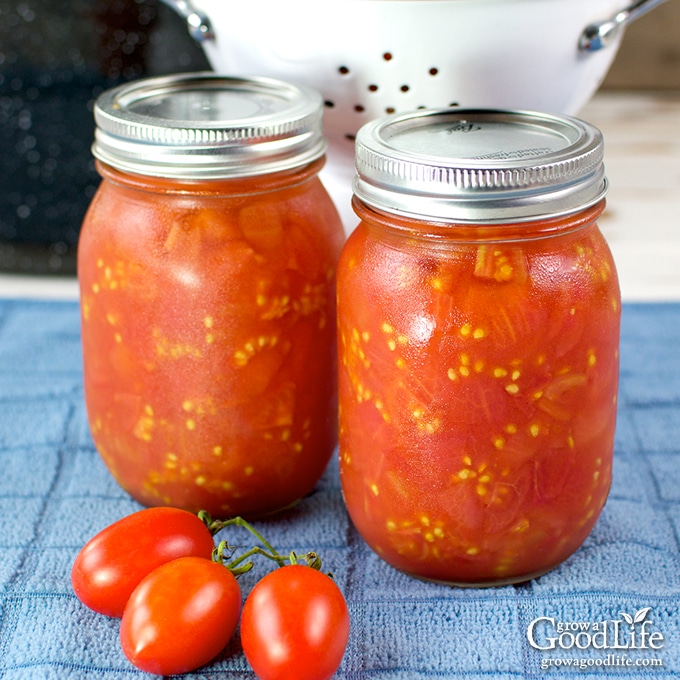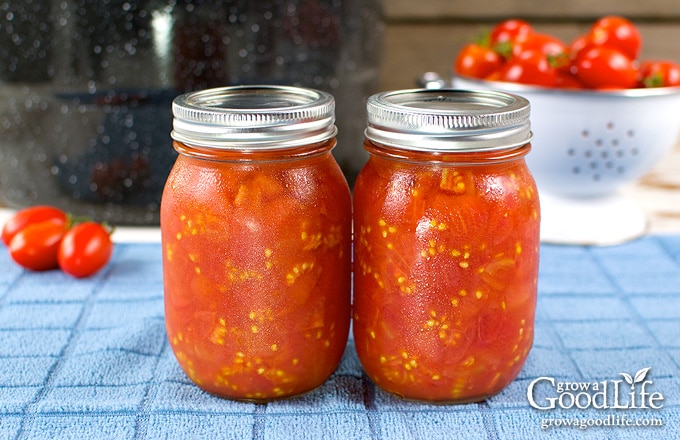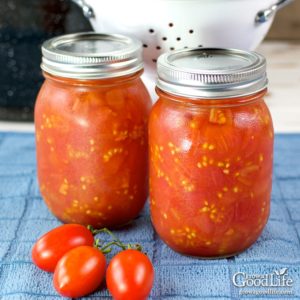Canning Crushed Tomatoes
This post may contain affiliate links, which means that I may receive a commission if you make a purchase using these links. As an Amazon Associate I earn from qualifying purchases.
Canning crushed tomatoes is an easy way to preserve an abundance of ripe tomatoes quickly. Canned tomatoes are handy to use in chilies, soups, stews, and casseroles.

My goal each year is to grow enough tomatoes to preserve tomato sauce and salsa to last us a year. Since we have a short growing season, this means planting a lot of tomatoes in early summer. The fruit begin to ripen in August and continues until frost kills the plants in October.
If the weather is exceptionally nice, the plants can produce a bumper crop. This is when things can get tricky.
It is so easy to get overwhelmed when the tomato harvest comes in all at once. It is a busy time in the kitchen making and canning sauce and salsa before the next round of tomatoes are ready.
There is only a small window available once tomatoes are ripe. If it is clear that I won’t be able to keep up with the tomatoes in baskets piled all over the kitchen, my strategy switches to survival… to get the tomatoes preserved in jars before they spoil.

Steps for Canning Crushed Tomatoes
Canning your own crushed tomatoes is a quick way to preserve a bumper crop of ripe tomatoes. You can use the canned tomatoes in so many ways, including adding to chilies, soups, and casseroles. You can also substitute canned crushed tomatoes for fresh in this tomato sauce recipe and tomato salsa recipe.
Before you begin, it may be helpful to review this article on water bath canning at the National Center for Home Food Preservation website.
This is a safe caning recipe from both the NCFHP website and the Ball Complete Book of Home Preserving. The full and printable recipe can be found at the bottom of this article, but these are the steps for canning crushed tomatoes.
The recipe below is for canning pint sized jars of crushed tomatoes in their own liquid using a water bath canner. If you would rather can in quart-sized jars, you will need about 22 pounds of tomatoes for a canner load of 7 quarts.
Step 1: Prepare the Canning Equipment
Gather your canning and kitchen equipment. You will need:
- Water bath canner and canning rack
- 9 pint jars (or 7 quarts)
- Lids and bands (new lids for each jar, bands can be reused)
- Canning tools: jar lifter, canning funnel, ladle, and bubble popper
- Kitchen scale
- Plus basic kitchen supplies such as a large stainless steel sauce pot, large bowl, towels, knife, large spoon, potato masher, and a cutting board.
Wash the canning jars, lids, and canning tools in warm, soapy water and rinse well. Inspect the jars carefully, and don’t use any that have cracks or chips, as these may break when heated.
Jars must be heated before filling to prevent breakage due to thermal shock. Place the jar rack into the water bath canner, set the jars upright in the canner, and add enough water to cover the jars. Bring the canner to a simmer (180˚F) for 10 minutes, and keep the jars hot until you are ready to fill them.
Follow the manufacturer’s directions for preparing the lids. Pre-heating lids is no longer necessary before using, but it is still safe to warm the lids if you want to. Just add them to the canner when you heat your jars.
Step 2: Prepare the Tomatoes
Weigh the tomatoes and wash well under clean, running water. You will need about 15 pounds of fresh tomatoes for a canner load of 9 pints, and 22 pounds for a canner load of 7 quarts.
To peel the tomatoes, bring a large saucepan of water to a boil and fill a large bowl with ice water. Dip your tomatoes into the boiling water until the skins crack and loosen – about 30-60 seconds. Check out this tutorial for more information: How to Peel Tomatoes.
Remove the tomatoes from the pot and place in the bowl of ice water to cool. Discard the water, peel, and core your tomatoes once they are cool enough to handle.

Step 3: Cook the Tomatoes
Quarter about a pound of the peeled tomatoes and place them into a large stainless steel saucepan. Heat the tomatoes over medium-high heat, and crush with a potato masher once they soften to release the juice.
Heating tomatoes quickly after cutting will help preserve the pectin in the fruit and prevent the canned tomatoes from separating in the jars.
Once the pot comes to a boil, cut the remaining tomatoes into quarters, and add these to the pot as your work. Stir frequently to prevent sticking.
There is no need to crush the additional tomatoes. They will soften with heating and stirring. Continue until all tomatoes are added, and then boil gently for 5 minutes.

Step 4: Can the Crushed Tomatoes
Lay a dry kitchen towel on the counter, and place the citric acid or lemon juice, canning salt (if using) nearby along with the measuring spoons.
Remove a hot jar from the canner, drain, and place on the towel. Keep the remaining jars in the canner, so they stay warm. Add the citric acid or lemon juice to each jar, salt (if using). Fill hot jars with the hot tomatoes leaving a 1/2-inch headspace at the top of the jar.
Run a bubble popper through the jar to release air bubbles. Wipe the rim with a damp towel to remove residue. Center a lid on the jar, place the band over the lid, and screw it on until fingertip tight. Place the jar back into the canner, and repeat with the rest of the jars.
Once the jars are in the canner, adjust the water level so it is covering the jars by two inches, bring the canner to a boil, and process the jars for the times indicated in the recipe below. Let the jars cool, test the seals, label and date the jars, and store in a cool, dark location for 12 to 18 months.

Canning crushed tomatoes is a quick way to preserve a bumper crop of ripe tomatoes. You can use the canned tomatoes in so many ways, including adding to chilies, soups, and casseroles. You can also substitute canned crushed tomatoes for fresh in this tomato sauce recipe and tomato salsa recipe.

Canning Crushed Tomatoes
Ingredients
- 15 pounds tomatoes (see notes for quarts)
- citric acid or bottled lemon juice
- canning salt optional for flavor
Instructions
Prepare the Canning Equipment:
- Wash your jars, lids, screw bands, and canning tools in hot soapy water. Rinse well to remove all suds. Set aside to air dry on a clean kitchen towel.
- Place the jar rack into water bath canner, place jars in the canner, and add water to cover. Bring the canner to a simmer (180˚F) for 10 minutes, and keep the jars hot until you are ready to fill them.
Prepare the Tomatoes:
- Wash your tomatoes in plain water.
- To peel the tomatoes, bring a large pot of water to a boil, and fill a large bowl with ice water.
- Dip your tomatoes into the boiling water until the skins crack and loosen – about 30-60 seconds. Remove the tomatoes from the pot and place in the bowl of ice water to cool. Peel and core your tomatoes once they are cool enough to handle.
- Quarter about a dozen of the peeled tomatoes and place them into a large stainless steel saucepan. Heat the tomatoes over medium-high heat, and crush with a potato masher once they soften.
- Once the pot comes to a boil, begin cutting the remaining tomatoes into quarters, and adding to the pot as your work. Stir frequently to prevent sticking. No need to crush these tomatoes. They will soften with heating and stirring. Continue until all tomatoes are added. Then boil gently 5 minutes.
Can the Tomatoes:
- Spread a kitchen towel on the counter. Use your jar lifter to remove a jar from canner, drain, and place on the towel. Keep the remaining jars in the canner so they stay hot.
- Add 1/4 teaspoon of citric acid or 1 tablespoon of bottled lemon juice to each pint sized jar. (Add 1/2-teaspoon citric acid or 2 tablespoons lemon juice to each quart jar.)
- Add up to 1/2 teaspoon of salt for pint jars (1 teaspoon of salt per quart), if desired for flavor.
- Use the canning funnel and ladle, and fill the warm jars with hot tomatoes leaving 1/2-inch headspace.
- Run the bubble popper through the jar to release air. Wipe the rim clean with a damp paper towel.
- Center a lid on the jar, and screw on the band until it is fingertip tight. Use the jar lifter to place the jar back into the canner, and repeat with the remaining jars.
- Once jars are all in canner, adjust the water level so it is at two inches above the jar tops.
- Cover the canner and bring to boil over high heat. Once water boils vigorously, process pint sized jars for 35 minutes (quart sized jars for 45 minutes) at altitudes of less than 1,000 ft. Adjust processing time for your altitude if necessary. (See notes)
- When processing time is complete, turn off heat, remove the cover by tilting lid away from you so that steam does not burn your face, and allow the canner to cool down and settle for 5 minutes.
- Spread a kitchen towel on the counter. Use a jar lifter to remove the jars one at a time from the canner. Keep the jars upright, and place them on the towel. Do not tighten ring bands or test the seals yet. Let the jars sit undisturbed for 12 to 24-hours to cool.
- After the jars have cooled for at least 12 hours, check to be sure lids have sealed by pushing on the center of the lid. The lid should not pop up. If the lid flexes up and down, it did not seal. Refrigerate the jar and use within a week.
- Remove the ring bands, wash, label, date the jars, and store the canned tomatoes in a cool, dark place between 50 to 70 degrees F for 12 to 18 months. Once the jar is open, refrigerate and use up within a week. Yields about 9 pint jars of crushed tomatoes.
Notes
- Pints at altitudes of 1,001 - 3,000 ft. is 40 minutes, 3,001 - 6,000 ft. is 45 minutes, and above 6,000 feet is 50 minutes.
- Quarts at altitudes of 1,001 - 3,000 ft. is 50 minutes, 3,001 - 6,000 ft. is 55 minutes, and above 6,000 feet is 60 minutes.
Nutrition
This recipe was originally published on October 8, 2017. Updated August 28, 2021: Removed the reference to canning diced tomatoes. There is no safe tested recipe for canning diced tomatoes. Confirmed with local extension office that testing failed because the density of the diced tomatoes is different than crushed. Canning crushed tomatoes is the only safe method using this recipe.
You May Also Like:
Good planning is key to a successful vegetable garden
Whether you are new to growing your own food or have been growing a vegetable garden for years, you will benefit from some planning each year. You will find everything you need to organize and plan your vegetable garden in my PDF eBook, Grow a Good Life Guide to Planning Your Vegetable Garden.


Do you have a particular variety of tomato you like to grow for canning?
Ari, I grow a lot of plum or paste tomatoes each year in the garden. My favorites are Roma, Amish paste, Juliet, and San Marzano.
Do you have to peel the tomatoes?
Bonnie, Yes, you need to remove the skins when canning tomatoes because the safe canning recipes have not been tested with skins. It may make the product unsafe. If you want to keep the skins, consider freezing crushed tomatoes instead.
Can you add herbs and spices like basil, oregano, parsley and garlic?
Aileen, Yes, you can safely add seasoning in the form of dried herbs. However, canning tomatoes plain makes it more versatile to use for recipes. For example, Italian seasoned tomatoes may not work with chili recipes. Instead, you season as you make the dish. I wouldn’t suggest adding garlic because it may affect the pH.
I just finished this wonderfully easy recipe. I am new at canning have done salsa and spaghetti sauce this year and just finished with remainder of tomatoes crushed and canned. I noticed my liquid is at the bottom and tomatoes at the top. Is this normal. It appears they all sealed well. Please let me know. Thanks you
Julie, It sounds like you have been busy. Welcome to the wonderful world of preserving your own food! Yes, it is perfectly normal for canned tomatoes to have some separation after canning. As long as you followed the canning recipe, your jars are safe to use. Here are some resources to help reassure you:
– Why did my tomatoes separate in the jar? – Iowa State University Extension Office
– Canned Tomatoes Separated – eXtension Ask and Expert
Can chopped onions be safely added to the chopped tomatoes for canning?
Barbara, Adding chopped onions changes the acid levels and may make your jars unsafe for canning. I am unable to find a tested canning recipe with just tomatoes and onions. You should freeze them instead of canning.
Why do you have to process?
Robin, Processing the jars of tomatoes in a water bath canner ensures safe storage at room temperature. The heat from boiling the jars kills bacterial cells found in the food. Boiling also removed oxygen and forms a tight seal between the lid and rim. You can freeze the tomatoes if you don’t want to can them.
Your recipe indicates 1 tablespoon of lemon juice, but is that for a pint or a quart? How much for each?
Carole, The recipe above is for PINT jars. If you are canning in quart jars, you’ll need to make some adjustments to can the tomatoes safely:
You’ll need about 22 pounds of tomatoes for 7 quart jars. Add 1/2 teaspoon of citric acid or 2 tablespoon of bottled lemon juice to each quart jar. Your processing time for quart jars is longer as well. Process quarts for 45 minutes at altitudes of less than 1,000 ft. (adjust processing time for your altitude if necessary).
When and how much of the lemon juice do you add in the process?
Carla, The amount is indicated in the recipe.
Can you use canned tomatoes to make salsa
Yes, you can 🙂
I just used a jar of tomato sauce and stewed tomatoes from last summer to make Albondigas soup. I am going to plant more Roma tomatoes this year for a larger batch of tomatoes to can. – Margy